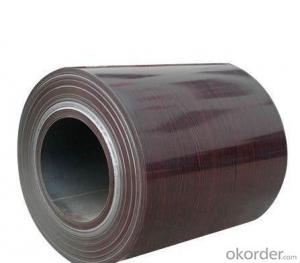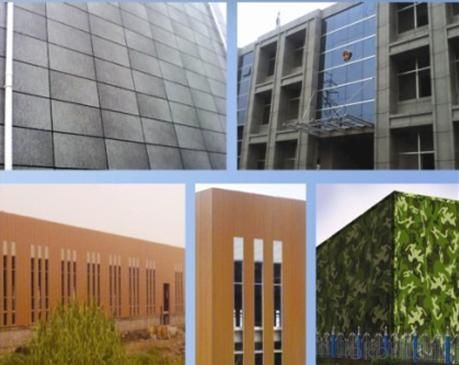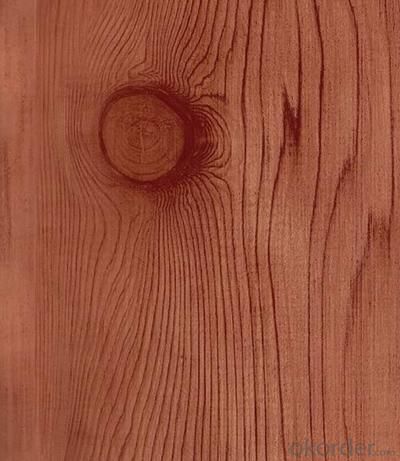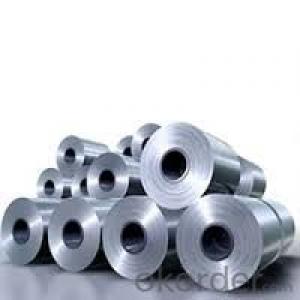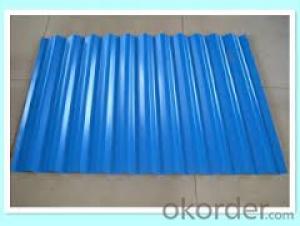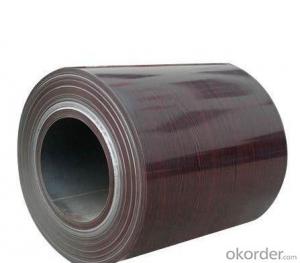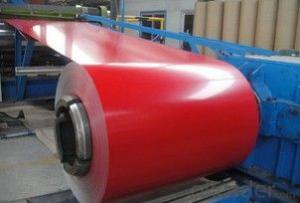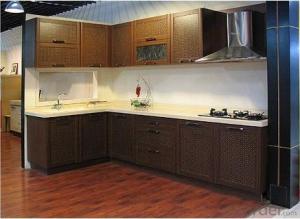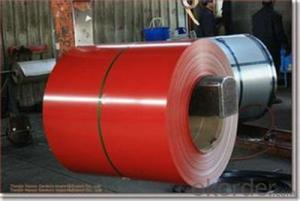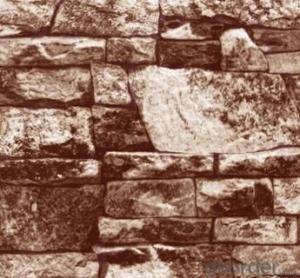Print Prepainted Galvanized Steel Coil Wooden Pattern-Hot Sale
- Loading Port:
- Shanghai
- Payment Terms:
- TT OR LC
- Min Order Qty:
- 12 m.t.
- Supply Capability:
- 5000 m.t./month
OKorder Service Pledge
OKorder Financial Service
You Might Also Like
1.Structure of Print Prepainted Galvanized Steel Coil Wooden Pattern-Hot Sale:
With GI as base metal,after pretreatmet (degrease and chemical treatment) and liquid dope with several Layers of color,then after firing and cooling,finally the plate steel is called pre-painted galvanized steel ( PPGI) .Pre-painted galvanized steel is good capable of decoration ,molding,corrosion resistance
2.Main Features of Print Prepainted Galvanized Steel Coil Wooden Pattern-Hot Sale:
• Excellent process capability
• Smooth and flat surface
• Workability, durability
• Excellent heat resistance performance
• High strength
• Good formability
• Good visual effect
3.Print Prepainted Galvanized Steel Coil Wooden Pattern-Hot Sale Images
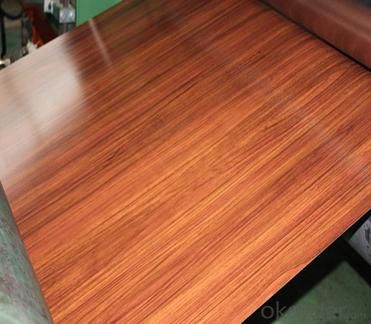
4.Print Prepainted Galvanized Steel Coil Wooden Pattern-Hot Sale Specification
Standard:ASTM, GB,JIS,JIS G3302 ASTM 755 EN10169
Grade: DX51D CGCC CS
Thickness: 0.13mm~3.0mm,
Width: 1250,600-1250mm
Coil weight:3-12 MT
Coil ID:508/610mm
Chemical composition:
C | Si | Mn | Cr | Ni | P | S |
0.150 | 0.476 | 11.231 | 12.50 | 0.900 | 0.039 | 0.010
|
5.FAQ of Print Prepainted Galvanized Steel Coil Wooden Pattern-Hot Sale:
We have organized several common questions for our clients,may help you sincerely:
1.How do you control your quality
We have established the international advanced quality management system,every link from raw material to final product we have strict quality test;We resolutely put an end to unqualified products flowing into the market. At the same time, we will provide necessary follow-up service assurance.
2.How long we will receive the goods ?
After receiving your deposit or workable lc ,our normal shipment date is 15-20days,and it takes around 28 days to reach your port of destination. But is up to different destination
3. What is your MOQ?
Normally our MOQ is 12mt per size ,but it is up to different size.
- Q: What are the different types of steel coil finishing equipment?
- There are several different types of steel coil finishing equipment used in various industries. These equipment are designed to perform specific tasks to ensure the steel coils are prepared and finished according to the desired specifications. Some of the commonly used types of steel coil finishing equipment include: 1. Slitting lines: Slitting lines are used to cut large steel coils into narrower strips. These machines have multiple slitting knives that can cut through the coil at high speeds, resulting in precise and clean cuts. Slitting lines are typically used in industries such as automotive, construction, and packaging. 2. Leveling lines: Leveling lines are used to flatten and straighten steel coils that may have uneven surfaces or irregularities. These machines use a combination of leveling rolls and tension control systems to ensure that the steel coils are perfectly flat and have consistent thickness throughout. Leveling lines are commonly used in the manufacturing of appliances, furniture, and metal roofing. 3. Recoiling lines: Recoiling lines are used to rewind steel coils into smaller coils of a specific diameter and weight. These machines are equipped with winding units that carefully wind the steel strip around a mandrel, creating compact and evenly wound coils. Recoiling lines are typically used in industries such as electrical, HVAC, and steel distribution. 4. Cut-to-length lines: Cut-to-length lines are used to cut steel coils into specific lengths as per the customer's requirements. These machines have precision measuring systems that accurately measure the length of the coil and hydraulic shears that cut the coil accordingly. Cut-to-length lines are commonly used in industries such as manufacturing, construction, and fabrication. 5. Coating lines: Coating lines are used to apply protective coatings or finishes on steel coils to enhance their corrosion resistance, durability, and appearance. These lines typically consist of cleaning and pre-treatment sections, where the coils are cleaned and treated with chemicals, followed by coating application sections where the desired coating material is applied. Coating lines are commonly used in industries such as automotive, appliances, and construction. These are just a few examples of the different types of steel coil finishing equipment available in the market. Each type serves a specific purpose and plays a crucial role in the manufacturing and processing of steel coils for various applications.
- Q: How are steel coils affected by global trade policies?
- Steel coils can be significantly affected by global trade policies. The imposition of tariffs or trade restrictions on steel imports can impact the availability and cost of steel coils in the international market. These policies can lead to increased prices, limited supply, and disrupted trade flows, ultimately affecting the steel coil industry worldwide. Conversely, the removal or reduction of trade barriers can foster a more open and competitive market, allowing for easier access to steel coils and potentially benefiting industries reliant on this material.
- Q: I want to start getting throwing knives and i was wondering what material is best for quality, but still cheap. I also saw some 440 stainless steel knives that i liked and wanted to know if the material was good
- For throwing knives, 440 isn’t necessarily a bad choice. Does it list whether it is 440c or 440b? That matters somewhat. The advantages of 440 Stainless is that it’s relatively hard (for a stainless), it resists rust significantly, and it’s not so hard that it would shatter or break. On the down side 440 is notorious for not taking or holding an edge, but for a throwing knife, that’s probably not much of an issue. If you’re looking for something to train with, you’re fine here. It’s plenty of steel enough to stick in wood or other targets. Odds are it won't bend if you slam it into some wood. If it lands on concrete, eh, it's going to scratch and all that jazz, and it might hurt the tip if it hits first, but as has been said, you can use a file or grinder to get the tip back.
- Q: What are the different types of steel coil packaging materials for export?
- Various steel coil packaging materials are commonly utilized for export. These include: 1. Steel Strapping: A frequently employed option, steel strapping ensures robust and reliable packaging for steel coils. It offers excellent protection during transportation and is available in different widths and thicknesses to accommodate varying coil sizes. 2. Stretch Film: This flexible and elastic material is often employed to wrap steel coils securely. By preventing shifting or falling during transit, stretch film ensures tight and dependable packaging. Moreover, its lightweight nature aids in reducing shipping costs. 3. Corrugated Cardboard: Frequently used as an outer packaging material, corrugated cardboard provides additional protection against external impacts and acts as a cushioning material. It is available in various strengths and sizes to suit different coil dimensions. 4. Wooden Crates: Wooden crates are a popular choice for packing larger steel coils. They offer a sturdy and robust packaging solution, effectively safeguarding against impacts, moisture, and other environmental factors. These crates can be customized to fit specific coil sizes and are often employed for heavy-duty or long-distance shipments. 5. Plastic Strapping: Plastic strapping serves as an alternative to steel strapping, particularly for lighter coils. It is lightweight, easy to handle, and resistant to rust and corrosion. Plastic strapping is available in different colors, facilitating easy identification and sorting. 6. VCI (Volatile Corrosion Inhibitor) Packaging: VCI packaging materials are specifically used to protect steel coils from corrosion during export. These materials release a vapor that forms a protective layer on the surface of the coils, preventing rust and corrosion even in high humidity or harsh environments. When selecting the appropriate packaging material for export, it is crucial to consider the size, weight, and specific requirements of the steel coils. Additionally, adherence to international shipping regulations and standards is essential to ensure a safe and efficient transportation process.
- Q: How are steel coils used in the shipbuilding industry?
- Steel coils are used in the shipbuilding industry for various purposes, including the construction of the ship's hull, decks, and other structural components. These coils are typically cut, shaped, and welded together to form the desired sections and structures of the ship. Additionally, steel coils are also used for the fabrication of equipment and machinery required for the ship's operation, such as engine components and piping systems. The high strength and durability of steel make it an ideal material for shipbuilding, ensuring the ships are capable of withstanding the harsh marine environment.
- Q: How do steel coils contribute to energy savings in buildings?
- Steel coils contribute to energy savings in buildings in several ways. Firstly, steel coils are often used as part of the insulation system in buildings. The high thermal conductivity of steel allows for efficient heat transfer, ensuring that the building remains well-insulated and energy loss is minimized. Additionally, steel coils are often used for HVAC systems, which play a crucial role in energy efficiency. By using steel coils in these systems, the heat transfer process can be optimized, reducing the energy required to heat or cool the building. Moreover, steel coils are durable and long-lasting, reducing the need for frequent replacements and maintenance, which in turn saves energy and resources. Overall, the use of steel coils in buildings helps to improve energy efficiency and reduce energy consumption, contributing to significant energy savings.
- Q: What are the different grades of steel used for manufacturing coils?
- There are several grades of steel that are commonly used for manufacturing coils. These grades are chosen based on their specific properties and suitability for different applications. Some of the most common grades of steel used for manufacturing coils include: 1. Low carbon steel (mild steel): This grade of steel is often used for manufacturing coils as it is relatively inexpensive and has good formability. It is suitable for applications that require low strength and high ductility, such as automotive components and construction materials. 2. High carbon steel: This grade of steel is known for its high strength and hardness. It is commonly used for manufacturing coils that require high tensile strength, such as springs and wires. 3. Stainless steel: Stainless steel is a corrosion-resistant alloy that contains a high percentage of chromium. It is commonly used for manufacturing coils that require resistance to corrosion and oxidation, such as in the food industry, medical equipment, and automotive applications. 4. Galvanized steel: Galvanized steel is coated with a layer of zinc to protect it from corrosion. It is commonly used for manufacturing coils that will be exposed to harsh environmental conditions or for applications that require excellent durability, such as roofing materials and electrical appliances. 5. Alloy steel: Alloy steel is made by adding elements such as manganese, nickel, chromium, or molybdenum to carbon steel. This improves its strength, hardness, and resistance to wear and corrosion. Alloy steel coils are commonly used in applications that require high strength and toughness, such as in the aerospace and automotive industries. It is important to select the appropriate grade of steel based on the specific requirements of the application to ensure optimal performance and longevity of the coils.
- Q: Are steel coils used in appliances manufacturing?
- Yes, steel coils are commonly used in the manufacturing of appliances. They serve as a key component in various appliances such as refrigerators, washing machines, and dryers, providing structural strength and stability to the overall product.
- Q: Steel being my favorite type, I just picked up Heart Gold today, my gf got Soul Silver...I was wondering which steel types are available and somewhat easily obtainable in HG (and/or what is the earliest steel type I can get?)
- Magnemite is the first steel type you can obtain. Get it by going to the Safari Zone in the mountain area. Magnetons are also found there. You can also evolve a Pineco into a Forretress. You can find Pineco by headbutting trees. Unfortunately, those are the only easy-to-find steels before the Pokemon league. Afterwards, you can obtain a Bronzor, Metagross, Steelix*, and Scizor*. Your girlfriend can trade you a Skarmory as well. Of all the ones listed, Forretress is probably the easiest to obtain, but Metagross is the best. I hope that helped. Contact me if you want more info! *Steelix and Scizor are obtained by trading an Onix or Scyther while holding a Metal Coat. Technically, you can get them before the Elite Four. However, you would need a friend to give you their Metal Coat, or get lucky and find one on a wild Pokemon, becaue the only one you get in-game is obtained after you beat the Elite Four.
- Q: How are steel coils used in the production of household appliances?
- Steel coils are used in the production of household appliances as the primary material for manufacturing various components, such as the outer body, frames, and structural parts. The coils are first shaped, cut, and formed into specific sizes and shapes, depending on the appliance being produced. These steel components provide strength, durability, and stability to the appliances, ensuring longevity and resistance to wear and tear.
Send your message to us
Print Prepainted Galvanized Steel Coil Wooden Pattern-Hot Sale
- Loading Port:
- Shanghai
- Payment Terms:
- TT OR LC
- Min Order Qty:
- 12 m.t.
- Supply Capability:
- 5000 m.t./month
OKorder Service Pledge
OKorder Financial Service
Similar products
Hot products
Hot Searches
Related keywords
